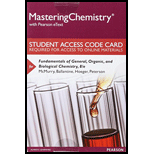
a)
Interpretation: The symbol of the Silver ion to be predicted.
Concept Introduction:
Naming monoatomic Ions: Main group metal cations are named by identifying the metal name, followed by the word ‘ion’.
Naming
Naming Anions: Anions are named by replacing the end of the element name with ‘-ide’, followed by the word ‘ion’.
b)
Interpretation: The symbol of the Iron ion to be predicted.
Concept Introduction:
Naming monoatomic Ions: Main group metal cations are named by identifying the metal name, followed by the word ‘ion’.
Naming Transition metal ion: In general, transition metal exhibits various oxidation state and the naming follows the rule, transition metal is identified by the name, followed by the oxidation number of the particular ion.
Naming Anions: Anions are named by replacing the end of the element name with ‘-ide’, followed by the word ‘ion’.
c)
Interpretation: The symbol of the Copper ion to be predicted.
Concept Introduction:
Naming monoatomic Ions: Main group metal cations are named by identifying the metal name, followed by the word ‘ion’.
Naming Transition metal ion: In general, transition metal exhibits various oxidation state and the naming follows the rule, transition metal is identified by the name, followed by the oxidation number of the particular ion.
Naming Anions: Anions are named by replacing the end of the element name with ‘-ide’, followed by the word ‘ion’.
d)
Interpretation: The symbol of the Tellurium ion to be predicted.
Concept Introduction:
Naming monoatomic Ions: Main group metal cations are named by identifying the metal name, followed by the word ‘ion’.
Naming Transition metal ion: In general, transition metal exhibits various oxidation state and the naming follows the rule, transition metal is identified by the name, followed by the oxidation number of the particular ion.
Naming Anions: Anions are named by replacing the end of the element name with ‘-ide’, followed by the word ‘ion’.
Want to see the full answer?
Check out a sample textbook solution
Chapter 3 Solutions
Mastering Chemistry with Pearson eText -- Standalone Access Card -- for Fundamentals of General, Organic, and Biological Chemistry (8th Edition)
- What is the mass in grams of 24.2 moles of NaCl?arrow_forwardA compound with empirical formula C2H5O was found in a separate experiment to have a molar mass of approximately 90 g. What is the molecular formula of the compound?arrow_forwardMagnesium atoms lose two electrons when they react. Write the symbol of the ion that is formed. Is it a cation or an anion?arrow_forward
- Ferrous sulfate is one dietary supplement used to treat iron-deficiency anemia. What are the molecular formula and molecular mass of this compound? howmany milligrams of iron are in 250 mg of ferrous sulfate?arrow_forwardEthylene glycol, the main ingredient in antifreeze, contains 38.7% carbon, 9.7% hydrogen and 51.6 % oxygen. Calculate the empirical and molecular formulas for ethylene glycol. Given the molar mass is approximately 60 g/mol. A) Empirical formula: B)Molecular formula: Explain how you obtained the Molecular formula (b)?arrow_forwardWhat is the mass in grams of 6.022 * 1023 O atoms of mass 16.00 amu?arrow_forward
- What is the difference between molecular mass and formula mass? Between molecular mass and molar mass?arrow_forwardA solution contains 2.2 x 10 -3 M in Cu2+ and 0.33 M in LiCN. If the Kf for Cu(CN)42- is 1.0 x 1025 , how much copper ion remains at equilibrium?arrow_forwardConsider the following acids and their ionization constant, determine which conjugate base is HCOOH Ka = 1.7 x 10-4 (b) HCN Ka = 4.9 x 10-10arrow_forward
- Another major use of bismuth has been as an ingredient in low-melting metal alloys, such as those used in firesprinkler systems and in typesetting. The element itself is a brittle white crystalline solid. How do these characteristicsfit with the fact that bismuth is in the same periodic group with such nonmetallic elements as nitrogenand phosphorus?arrow_forwardWhat enables a radioisotope to substitute for an ordinary (nonradioactive) atom of the same element molecule?arrow_forwardWhen 0.5 mol of a certain ionic substance is dissolved in 1.0 kg of water, the freezing point of the resulting solution is -2.8 °C (270.35 K), How many ions does the substance give when it dissolves?arrow_forward
 Principles Of Radiographic Imaging: An Art And A ...Health & NutritionISBN:9781337711067Author:Richard R. Carlton, Arlene M. Adler, Vesna BalacPublisher:Cengage Learning
Principles Of Radiographic Imaging: An Art And A ...Health & NutritionISBN:9781337711067Author:Richard R. Carlton, Arlene M. Adler, Vesna BalacPublisher:Cengage Learning Biology (MindTap Course List)BiologyISBN:9781337392938Author:Eldra Solomon, Charles Martin, Diana W. Martin, Linda R. BergPublisher:Cengage Learning
Biology (MindTap Course List)BiologyISBN:9781337392938Author:Eldra Solomon, Charles Martin, Diana W. Martin, Linda R. BergPublisher:Cengage Learning




